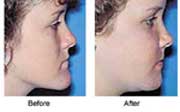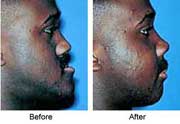Services: Oral Surgery: Orthognathic Surgery
Orthognathic Surgery
Orthognathic surgery refers to the surgical repositioning of the maxilla, mandible, and the dentoalveolar segments to achieve facial and occlusal balance.
One or more segments of the jaw can be simultaneously repositioned to treat various types of malocclusions and jaw deformities.

Orthognathic Treatment
Preoperative diagnosis and planning for patients with jaw asymmetries and deformities is first done by the Pedodontist/Orthodontist in coordination with the craniofacial surgeon. All findings are analyzed and pre-surgical model surgery performed to ascertain the feasibility of various treatment options.
Usually, pre-surgical orthodontics are necessary to straighten the teeth and align the arches so that a stable occlusion can be obtained post-operatively, while orthodontics following surgery are frequently required to revise minor occlusal discrepancies.
Orthognathic surgery is often delayed until after all of the permanent teeth have erupted unless medical conditions necessitate that the surgery be performed earlier. In adult patients, orthognathic surgery can be combined with soft tissue contouring to improve the aesthetic results.
Maxillary advancement is a type of orthognathic surgery that may be necessary to improve the facial contour and normalize dental occlusion when there is a relative deficiency of the midface region. This is done by surgically moving the maxilla with sophisticated bone mobilization techniques and fixing it securely into place.


Depending on the soft tissue profile of the face or the severity of an occlusal discrepancy, problems with the lower face may require surgery on the mandible. This can be done in conjunction with or separate from maxillary surgery. The mandible can be advanced, set back, tilted or augmented with bone grafts. A combination of these procedures may be necessary.
Pre-operative planning is crucial to the success of the procedure and evaluates the surgical and orthodontic options. The surgeon chooses the type of mandibular surgery based on his experience, evaluation of the photographic and cephalometric analysis, and model surgery.





